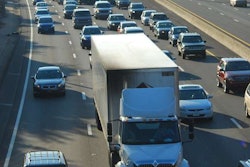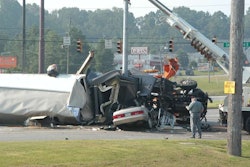Back in 2009, the U.S. Department of Energy doled out nearly $200 million to four truck OEMs and Cummins to develop a Class 8 “SuperTruck” capable of achieving 50 percent improvement in freight efficiency and reduction in fuel use and greenhouse gas emissions compared to pre-EPA 2010 engine trucks. What at the time sounded like lofty goals at best – and a waste of taxpayer dollars at worst – the DoE SuperTruck program be closer to hitting the mark than many people thought possible.
At a press conference last week in Los Cabos, Mexico, TJ Reed, director, product strategy for Freightliner Trucks, said DTNA has completed Phase One of its SuperTruck program, achieving a 25 percent improvement in freight efficiency to date when compared to its base model, a 2009 Cascadia with EPA 2007-compliant 455-hp DD15 engine, 72-inch raised roof sleeper with a 6×4 axle configuration.
“At the halfway point as an aggregate, the programs are trending positively,” said Reed. “We feel extremely good about where we are going and the challenge in front of us as we continue to 50 percent [freight efficiency] and beyond.”
Reed also said many of the concepts developed with the SuperTruck program, including an integrated powertrain, 6×2 optimization and enhanced aerodynamics have already been transferred to the market, citing the Freightliner Cascadia Evolution tractor as an example.
“These aren’t just science projects – we are actually delivering a lot of the R&D technology today,” said Reed.
For Phase 2, which DTNA expects to complete in 2015, DTNA breaks down improvements in three main design criteria: improving fuel economy, removing weight from the tractor and trailer and improving idling strategies.
Reed said DTNA will meet 30 percent of its goal through tractor-trailer improvements, including aerodynamics, powertrain integration and weight reduction. The remaining 20 percent will be realized through improvement in engine technology such as parasitic loss improvement and brake thermal efficiency (how well an engine translates heat from fuel into mechanical energy).
“We’re working with our global hybrid center in Japan to take a parallel hybrid motor between the engine and transmission to capture power either from waste heat recovery or brake regeneration that can be stored in batteries for hotel loads or applied to propulsion,” said Reed. “We’re also working on total HVAC systems rather than having an APU and HVAC from the chassis.”




![BennettFarrowAbate[3]](https://img.ccjdigital.com/files/base/randallreilly/all/image/2013/02/ccj.BennettFarrowAbate3.png?auto=format%2Ccompress&fit=crop&h=167&q=70&w=250)






